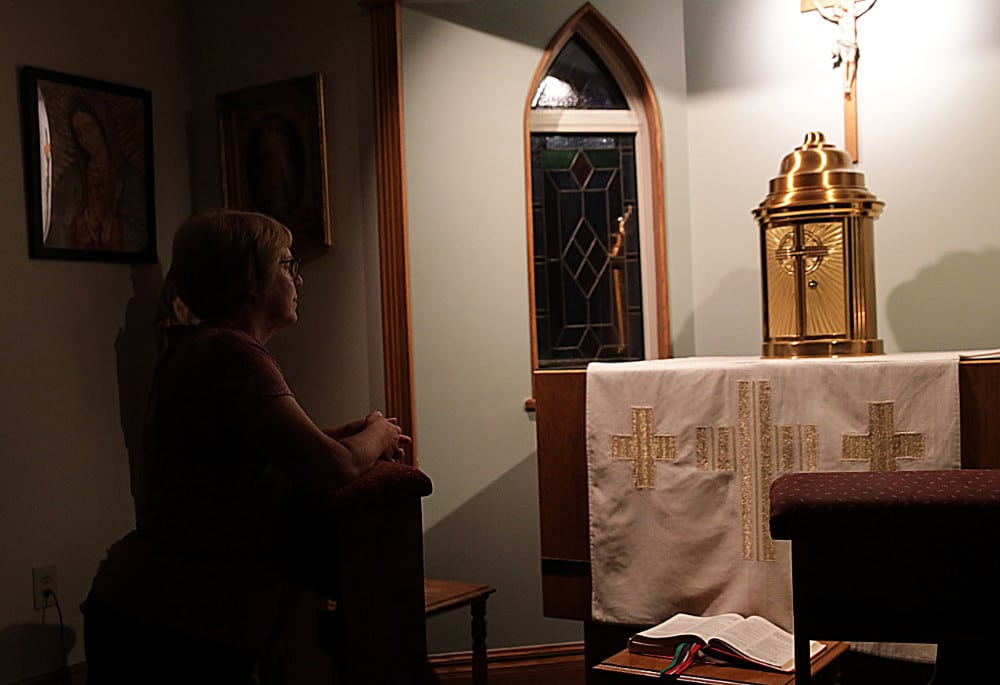 Question: Please describe the difference between adoration of the Blessed Sacrament when it is in the tabernacle vs. when it is exposed in the monstrance.
Question: Please describe the difference between adoration of the Blessed Sacrament when it is in the tabernacle vs. when it is exposed in the monstrance.
— Jo Hasler, Malta, Montana
Answer: Human beings are sensory insofar as we have five senses to perceive the world about us: sight, taste, touch, hearing and smelling. As sensory creatures, we are best assisted when these senses are engaged. Especially important to us is the capacity to see and hear.
Hence, the manners of encountering the true presence of the Lord in the holy Eucharist have this first distinction — namely, that adoration more fully engages our capacity to see the sign of the sacramental and true presence of the Lord in the sacred host. This has a way of focusing our attention. The design of the monstrance, shaped like a golden sunburst, further enhances our focus. This also fosters an atmosphere of solemnity and claims the exclusive presence of all in the church or chapel. Other activities such as choir rehearsals or liturgical practices are not to be going on in that space at the time.
The Lord in the tabernacle is no less present, but, given our sensory nature, his presence is less exclusively focused for us, so our “sensibilities” are changed. We are more inclined to permit wedding rehearsals or other special gatherings in the church or chapel even with a tabernacle and the Lord present there.
Some may argue that we should behave no differently whether the Lord is present in the monstrance or in the tabernacle. But this may not be practical or possible. The church building is often needed for things other than prayer or silent adoration. It is often the largest place on the parish grounds to gather for larger parish meetings of a religious nature. It is also necessary to conduct rehearsals there, etc. Even if we should behave no differently, the fact that we do behave differently before the monstrance signals a special, solemn and exclusive Eucharistic focus, whereas the tabernacle signals the Lord’s presence for prayer or as we engage in his work of preaching, teaching, preparing for liturgies and so forth. We honor his presence by being about his work in the nave or sanctuary as needed in a way that we pray will please him. The danger in not permitting this insight led some in the past to relegate the tabernacle to an isolated spot so as to be “out of the way” of other activities, even to avoid it becoming too “central” in the celebration of the Mass. Honoring the Lord’s presence in both a solemn way (in adoration) and a more mitigated way (in the tabernacle) is helpful, and we can enjoy the best of both worlds, but it is not right to honor him by hiding him away.
A visitation to the Church and praying before Jesus in the tabernacle is pleasing, should be a regular feature of most Catholic lives, and should be encouraged in parishes by facilitating access to the church for the faithful. Churches can be unlocked during the day, or a special entrance or security code can be supplied in dangerous or lonely settings. This was very common prior to the 1970s whereas Eucharistic adoration was less frequent. It was featured especially during “Forty Hours” and other special occasions. Occasionally there was brief adoration after Mass on Fridays, but lengthy (even 24/7) adoration was very rare. With the decline of Eucharistic piety by some, it was thought a good remedy to expand the solemn adoration of the holy Eucharist. This has largely been a blessing for the Church, but we should not forget the beauty of simple and quick visits to Jesus in the tabernacle as well.
Saint statue details
Question: We have a statue of St. Joseph in our Catholic church, and he has a young Jesus in his left arm and a lily in his right. His right foot is on a book. What is the significance?
— Al Huth, Kendallville, Indiana
Answer: If it is St. Joseph, it is exceptionally rare. My best guess is that it is a reference to the genealogy of Jesus that the Gospels trace through Joseph. Though Jesus is only related to Joseph by Mary’s marriage to Joseph, nevertheless, the members of Joseph’s family tree are Jesus’ “in-laws.” Hence, Joseph is standing upon the Gospels that describe his own ancestors and holds Jesus who, while born only of Mary according to the flesh, is now united also to Joseph’s lineage by law of marriage.
Msgr. Charles Pope is the pastor of Holy Comforter-St. Cyprian in Washington, D.C., and writes for the Archdiocese of Washington, D.C. at blog.adw.org. Send questions to msgrpope@osv.com.







